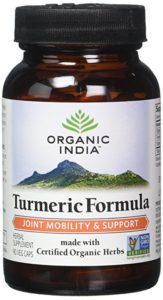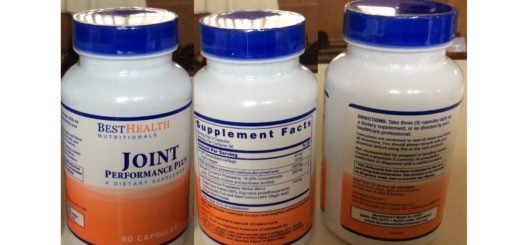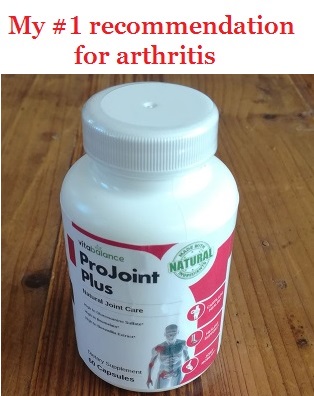My Organic India Turmeric Review – Good Enough For My Arthritis?
It’s time for my Organic India Turmeric review, a supplement that caught my eye because of its organic source. Obviously, I can never know if it’s really organic or not, but at first sight, it really seemed so.
However, it doesn’t have the best ingredients I’ve seen and their doses could be better, in my opinion.
So does this product really work? At first sight, it doesn’t seem like a scam, but who knows? Is it good enough to relieve my rheumatoid arthritis pain? It’s time to dig deep into this product.
Note: My review is based on my experience with this supplement, so it may or may not agree with other reviews you find. I am not criticizing/praising the product or the company, I am simply referring to how it worked for me
So Let’s Get To The Review
 Full Name: Turmeric Formula from Organic India
Full Name: Turmeric Formula from Organic India
Quantity : 90 capsules
Best Actual Price: $22.66
Where I Bought It From: Ebay, but you can also find it on Amazon
Worth Buying?: Not really, because it has pretty low doses of everything and there’s no bioperine. It does have good points (ginger), but it doesn’t do much in terms of pain (at least in my case)
My Rating: 2.20/10
What I Liked About It
- It contains ginger extract, an ingredient I haven’t seen in many turmeric supplements. Though it’s a pretty low dose, it brings an extra help for inflammation
- There’s a pretty good dose of curcuminoides (curcumin extract). This substances works anyway, but its high dose is definitely a big advantage for me
- You have to take only 2 pills per day, which is really okay. They also let you take them whenever you want, which probably means that the effect is the same either way
- You can find a lot of reviews about it, so it’s not one of those “ghost” products (I’ve read both positive and negative reviews, so I think it depends of what kind of pain the reviewer has)
What I Didn’t Like About It
- There’s no bioperine, which decrease the quantity of curcumin that your body will absorb (less than half)
- I read on the website that it has a special formula that increases absorption, but I don’t understand how it can be, since there’s no bioperine (it didn’t reduce my pain, so it makes me think there’s no better absorption)
- I took one whole bottle (for 5 weeks) but I didn’t notice any improvement in pain, stiffness or inflammation. That’s why I believe that it’s too weak for someone with a chronic pain
- For what it does, I believe it’s quite expensive. I could get some products that work much better for the same price (or even a lower one)
- (It didn’t happen to me, but I saw it mentioned in lots of reviews) You may receive an expired product, so in this case returning is the best thing to do
The Ingredients Aren’t Very Impressive
 Just like I do with any supplement, I first checked out the ingredient list of Organic India’s turmeric.
Just like I do with any supplement, I first checked out the ingredient list of Organic India’s turmeric.
Except the ginger extract, there wasn’t anything else that drew my attention. The substances inside were pretty common for turmeric supplements. But let’s take each of them by turn:
- Organic turmeric rhizome (740 mg) – this must be the turmeric powder, though I haven’t seen it named like this usually. I really appreciate that it’s organic, because organic turmeric has a much deeper effect than processed one.
But other than that, the dose is pretty low. The average supplements contain about 1000-1500 mg per serving, so this is almost half of that amount. That’s the first downside I found about this supplement.
- Turmeric extract (160 mg) – this is an ingredient that I really love, because it makes the difference between a good and a basic turmeric supplement. If you ever heard of “curcuminoides”, well, it’s the turmeric extract. Studies proved that curcuminoides decrease inflammation better than curcumin itself. So once these 2 substances are put together, the anti-inflammatory effect is much better.
I’m also really satisfied with this dose. 160 mg is more than enough, because you don’t need as much curcuminoides as curcumin. So overall, this dose is great.
- Organic ginger rhizome (100 mg) – that’s the ingredient I never expected to see here. Ginger is another anti-inflammatory herb, and even though it’s not as strong as turmeric, it does help. Especially in this combination.
However, the dose is pretty low. So I don’t think it can do anything extra, besides the turmeric.
Bioperine Would Have Been Essential
This is probably the biggest problem of many turmeric supplements.
Though they have the right ingredients in decent doses, they all lack one essential thing – a few milligrams of bioperine.
I will not enter any details about bioperine, but it basically increases the absorption of curcumin by up to 2000%. That’s because our body cannot absorb curcumin properly, so more than half is eliminated. That’s what studies say. So that’s the reason why bioperine is so important.
Unfortunately, there’s no bioperine in this supplement either. So no matter how organic it is, this is a pretty big disadvantage, in my opinion. At this price, bioperine should have been a must.
That’s the second bad thing I found about this supplement, besides the low dose of turmeric.
Therefore, My Body Gets Less Than 350 mg Turmeric
 That’s the conclusion I reached after seeing the ingredient list.
That’s the conclusion I reached after seeing the ingredient list.
I was telling you before that 740 mg is a pretty low dose of turmeric, at least if you want to get a permanent relief. But as there’s no bioperine, things are even worse.
From those 740 mg less than 50% will get absorbed properly, the rest will be eliminated directly. That means my body would get 350 mg of turmeric at most (but probably even less).
Well, 350 mg is a very small concentration for chronic inflammation. It would probably work for a minor pain, but other than that, I don’t think it could do much.
That’s why I didn’t trust this supplement much, even before I tried it. I knew my body very well and sometimes it didn’t even react to doses of 1000 mg. So 350 mg is really little compared to that. For this reason, I didn’t make great expectations from this supplement, because it wasn’t right for my body and my condition.
And to be honest, you would have to have a pretty minor pain to see some good results. That’s what I found out from different studies.
Does It Really Have A Superior Bioavailability?
According to the official description, Organic India’s Turmeric has a special formula for an increased absorption and longer bioavailability.
Well, that sounds great, but unfortunately I haven’t found any proof that this might be true.
First of all, you can’t really have a better absorption with these ingredients. Ginger and curcuminoides can’t make turmeric absorb better, at least I haven’t found that anywhere. Our body does absorb curcuminoides better than turmeric itself, but that doesn’t change anything in how it absorbs turmeric.
So from what I know (and tell me if I’m wrong), this claim couldn’t be true.
Secondly, there are certain types of curcumin that are created to have a better absorption alone. So in that case, you wouldn’t need any additional helpers, like bioperine. You surely heard of Meriva curcumin, didn’t you? Well, that’s an example of a better absorbed curcumin.
On the other hand, this product’s label doesn’t mention anything special. It only says “turmeric extract” (which is actually curcumin, as curcumin = turmeric extract), “curcuminoides” and “ginger extract”. Yes, I didn’t mention “organic”, but that doesn’t matter in this case.
So there’s no Meriva or other type of special curcumin. That’s why I doubt whether it has a better absorption or not. In my opinion, it does not.
I Tried One Bottle Myself
 Even though I wasn’t hoping for a major relief, I decided to give this supplement a real try. I did it more for the sake of this review, but that doesn’t matter much.
Even though I wasn’t hoping for a major relief, I decided to give this supplement a real try. I did it more for the sake of this review, but that doesn’t matter much.
I bought the product from Ebay (because I found a better price) and I received pretty fast, after about one week.
The bottle looked exactly like in the pictures, the ingredients had the same doses and it wasn’t expired. (I read a lot of reviews where people said they got expired supplements, but this wasn’t the case now.)
My Initial Pain: It was the typical RA pain, with flare-ups in certain periods. My pain was about a 6.5-7, depending on the day, and my hands and knees were the most painful parts. They were usually in pain, unlike my shoulders for example.
Obviously, it was worse in the morning and after sitting down for a longer time.
Week 1: I was taking 2 pills of this product, one in the morning and one in the evening. The label didn’t mention how to take them, so I was just following the schedule I thought would be best.
But as I expected, there was no relief in the first days. And by this I mean absolutely no change, it wasn’t even like my stiffness got a bit better.
Week 3: 2 weeks went by and I didn’t experience any improvement. It was pretty much like I wasn’t taking anything. Was it because of the low dose of turmeric? Or was it because there was no bioperine? Probably both.
Week 5: That’s when my bottle ran out. At the end of one month, I started taking 3 pills per day, because I saw no improvement. Even after that, there was still no major change.
My knees and ankles remained swollen, my hands were very stiff in the morning and my pain had not decreased almost at all. The fact that I started taking 3 pills didn’t change anything.
My 5 Months Conclusions
So I finished the treatment without any visible improvement neither in my pain, or in my general condition.
Conclusion #1: This supplement is pretty weak, at least compared to other alternatives from the market. Let’s skip the fact that it doesn’t have any bioperine.
740 mg of curcumin is still pretty low, compared to what you can get. Yes, there are also 160 mg of curcuminoides, but I wouldn’t count them in because they are another substance. So that’s the first downside of this supplement, and I didn’t even have to try it to understand this. The label says it all.
Conclusion #2: It’s not that good for chronic pain or arthritis. Why? It’s simply too weak to work for something else than a minor pain. Most people that are interested in turmeric products suffer from a chronic pain. So how could this supplement help them? In my opinion, that’s pretty hard.
Conclusion #3: It costs a lot for what it does (and for what it contains). I paid about $25 for it, but I’ve seen that prices lowered a bit lately, at least on Ebay. You can find a lot of different sellers, so you can find it for less than $22.
Now, I’m not saying $20 is much, but for a supplement that doesn’t bring relief, it is much. That’s why it seems expensive to me, because I can’t say it helped me at all. If it did, I would probably have been quite satisfied at this price.
My Final Verdict – Is It Worth Trying?
Short answer: Just like many similar supplements, only if you have a minor pain. Otherwise it won’t help you much, depending on what kind of pain you have.
My personal answer: I would not buy it again, that’s for sure. For me, it really didn’t change anything. Excluding the pain, my stiffness didn’t decrease and the inflammation from my legs and ankles was as bad as before. I could see that from the outside, so it’s not a matter of feeling the pain or not.
So overall, I wouldn’t recommend this product. In my opinion, it’s pretty expensive for the formula it comes with. There’s no bioperine, the doses are pretty low and I didn’t notice that better absorption they were talking about.
But at the end of the day, pain improvement is what matters the most and I didn’t get any of that improvement. So this product isn’t on my recommendations list.
I prefer to spend the same money to get something that relieves my pain almost completely (obviously, with bioperine).
So have you tried Organic India’s turmeric? Did it help you more than it helped me? I’d be glad to hear different opinions about this supplement, so let me know your answer in a comment and I will reach out to you.







